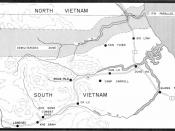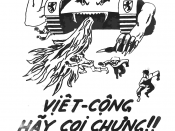After President Kennedy's assassination, Lyndon B. Johnson took on the presidency and the affairs in Vietnam. In August 1964, he secured from Congress the Tonkin Gulf Resolution, a declaration of war. In February and March 1965, Johnson certified the continued bombing, by United States aircraft, of targets that are north of the 17th parallel. On 8 March Johnson shipped 3,500 Marines to South Vietnam.
From February 1965 to the end of United States involvement in 1973, South Vietnamese forces mainly fought against the Vietcong guerrillas. United States and allied troops fought the North Vietnamese in a war of slow destruction marked by battles victories for the non-Communist forces. During the 1967-68 campaign of North Vietnamese strategists, they launched the Tet Offensive, an organized series of attacks on over than 100 targets. The campaign, which the strategists hoped would be influential, failed, and Vietcong forces were eventually driven back from most of the positions they had gained.
In the fighting, North Vietnam lost 85,000 of its troops.
On March 31, 1968 President Johnson proclaimed a halt in U.S. bombings over North Vietnam. The statement which was planned as a new peace gesture stirred up a positive answer from Hanoi, and in May peace talks were lengthened to include South Vietnam. The talks, however, made no development in spite of the fact that United States attacks on North Vietnam were completely halted in November.
The massacre of My Lai sent shockwaves through the United States Political establishment and the American public. The "search and destroy" mission caused the death of 300 civilians with no reports of opposing fire. According to eyewitness intelligence offered after the event, several old men were bayoneted, praying women and children were shot in the back of the head, and at least one girl...


